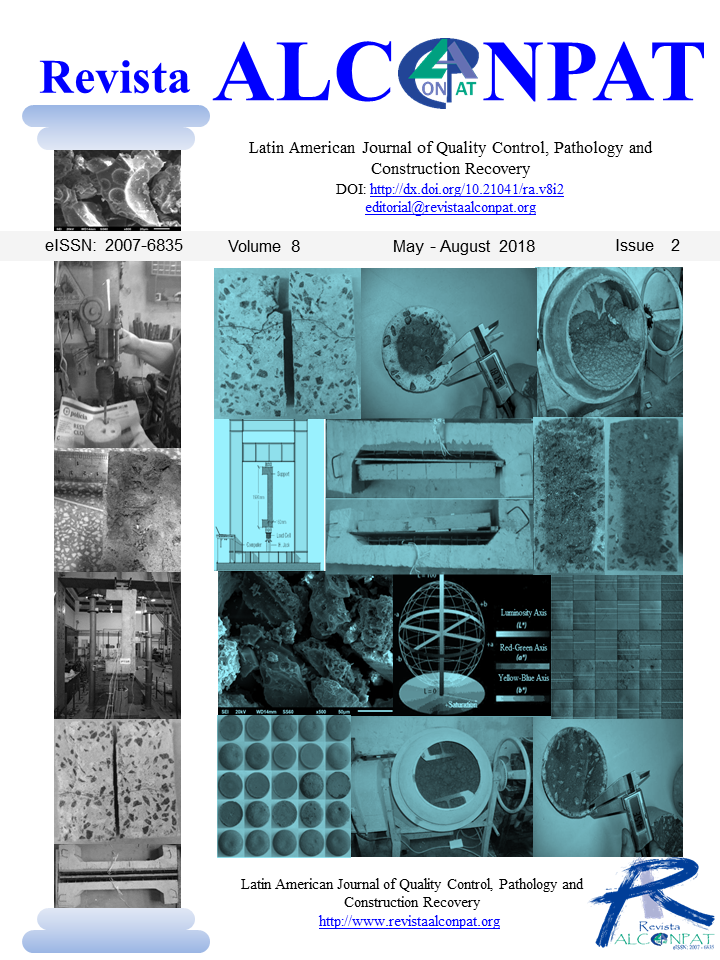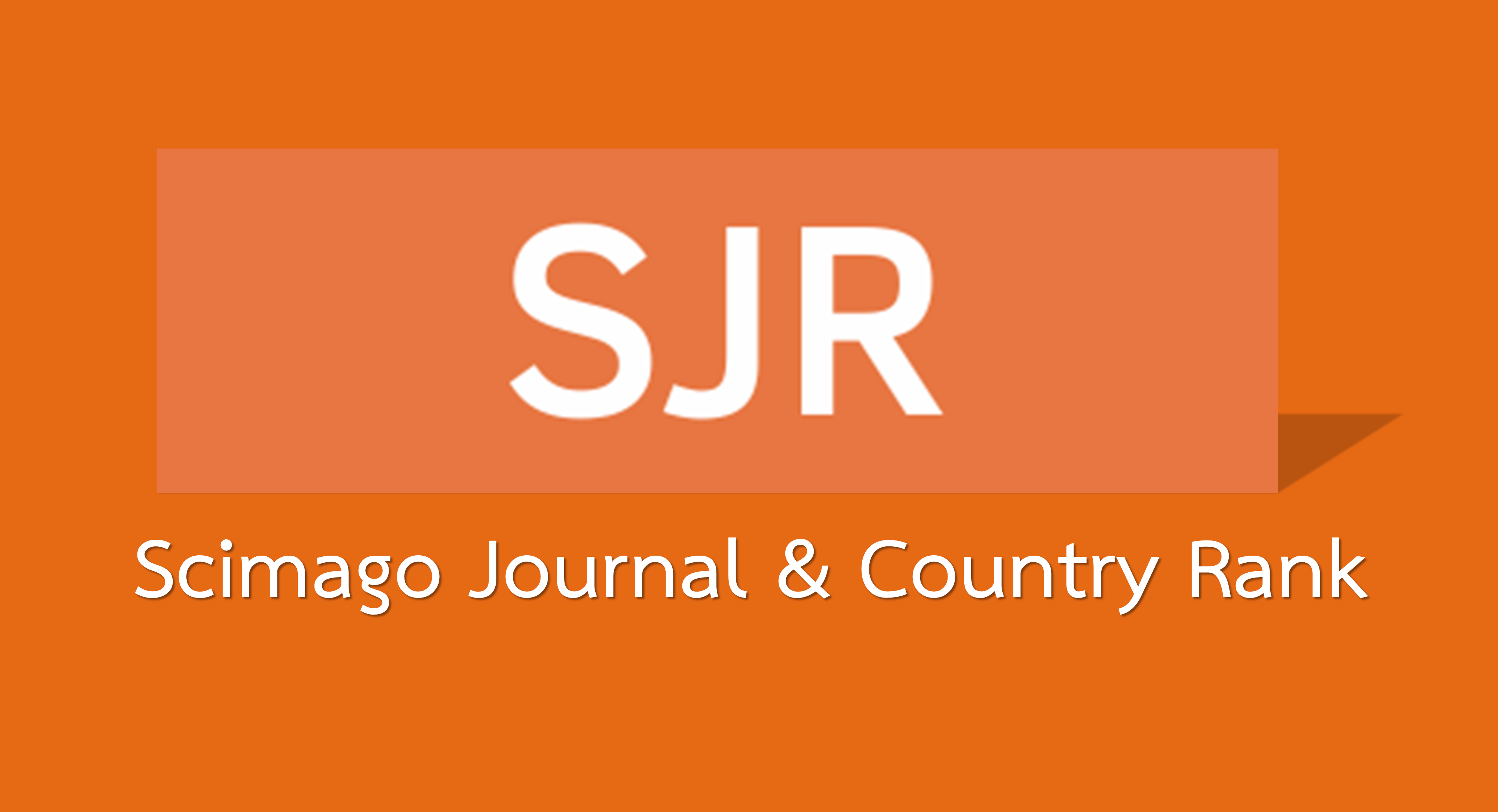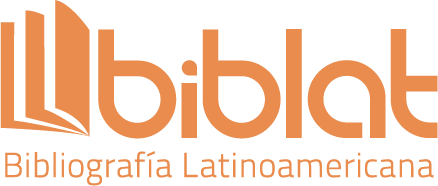Colorimetry of modified clays with mineral and organic additions
DOI:
https://doi.org/10.21041/ra.v8i2.277Keywords:
clay, colorimetry, additions, restorationAbstract
The objective of this investigation was to quantify the colorimetric values of different clays with some additions. Exploring the aesthetic appreciation, based on the clay color, of different additions percentages (by clay mass) with Santiago Undameo Bank, Mexico, clays as main matrix. Clay was kaolinite and the additions were gypsum, lime, opuntia cactus mucilage, portland cement, and sodium hydroxide. The addition percentages were 2%, 4%, 6%, 8% and 10%. The best colorimetric performances were obtained from Portland cement at 6%, sodium hydroxide at 4%, lime and gypsum at 8% and opuntia cactus mucilage at 4% and 8%. Some buildings where these clay materials were used are: Casas grandes en Paquimé, Chihuahua, La Venta en Tabasco, Yácatas en Tzintzuntzan, among others.
Downloads
References
Ahmed, A., Keizo, U. (2011), Environmental effects on durability of soil stabilized with recycled gypsum. Cold Regions Science and Technology. 66(2 & 3): 84-92. https://doi.org/10.1016/j.coldregions.2010.12.004
Ahmed, A., Usama, H. I. (2014), Stability of soft clay soil stabilised with recycled gypsum in a wet environment. Soils and Foundations. 54(3):405-416. https://doi.org/10.1016/j.sandf.2014.04.009
Anikwe, M. A. N., Eze, J. C., Ibudialo, A. N. (2016), Influence of lime and gypsum application on soil properties and yield of cassava (Manihot esculenta Crantz.) in a degraded Ultisol in Agbani, Enugu Southeastern Nigeria. Soil and Tillage Research. 158: 32-38. https://doi.org/10.1016/j.still.2015.10.011
Flores Ponce, A. (2018), “Morteros base arcilla, estabilizados con adiciones orgánicas y minerales para su uso patrimonial”, tesis de Licenciatura en Ingeniería Civil, Universidad Michoacana de San Nicolás de Hidalgo, pp. 20-31.
Benjamin, W. A. (1969), “Introduction to Crystallography”. New York, USA, Inc., pp. 83–100.
Besoain, E. (1985), “Mineralogía de arcillas de suelos”. San José, Costa Rica. IICA, pp. 997–1013.
Carrol, D., Starkey, H. C. (1971), Reactivity of clay minerals with acids and alkalies. Clays and Clay Minerals. 19: 321-333.
Cuellar López, A. M. A. (2014), “Tecnología de Morteros Constructivos de Tierra: una tradición en la vertiente del Lerma Medio en el Epiclásico”, tesis Maestría Arquitectura, Universidad Michoacana de San Nicolás de Hidalgo, Morelia, México,pp. 50-125.
Ma, C., Qin, Z., Zhuang, Y., Chen, L., Chen, B. (2015), Influence of sodium silicate and promoters on unconfined compressive strength of Portland cement-stabilized clay. Soils and Foundations. 55(5):1222–1232. https://doi.org/10.1016/j.sandf.2015.09.021
Dana, E. S., Ford, W. E. (1986), “Tratado de Mineralogía”, Editorial Cecsa, Decimotercera Impresión, México, pp. 741-745.
De León Ambrosio, B. (2017), “Estabilización De Arcilla Para Uso En Estructuras Patrimoniales: Evaluación De Sus Propiedades Físico-Mecánicas A Edades Tardías”, tesis de Licenciatura en Ingeniería Civil, Universidad Michoacana de San Nicolás de Hidalgo, pp. 50-65.
Dyson, D. J. (2004), “X – Ray and Electron Diffraction Studies in Materials Science”. Londres, Inglaterra. Editorial Maney Publishing, pp. 77–97, 115–134.
De Aquino, R. E., Marques, J., Costa Campos, M. C., de Oliveira, I. A., de Souza Bahia, A. S. R., Coutrim dos Santo, L. A. (2016), Characteristics of color and iron oxides of clay fraction in Archeological Dark Earth in Apuí region, southern Amazonas, Review Article. Geoderma. 262:35-44. https://doi.org/10.1016/j.geoderma.2015.07.010
Flores Rentería, A. (2010), “La norma ASTM D 6276 como instrumento de estabilización de suelos para fines patrimoniales”, tesis de Licenciatura en Ingeniería Civil, Universidad Michoacana de San Nicolás de Hidalgo, pp. 15-35.
Gómez González, M. L. (2008), “La restauración. Examen científico aplicado a la conservación de obras de arte”. 5ª Edición. Madrid, España. Cátedra, pp. 31–37.
Gupta, D., Kumar, A. (2017), Performance evaluation of cement-stabilized pond ash-rice husk ashclay mixture as a highway construction material. Journal of Rock Mechanics and Geotechnical Engineering. 9:159-169. https://doi.org/10.1016/j.jrmge.2016.05.010
Hotineanu, A., Bouasker, M., Aldaood, A., Al-Mukhtar, M. (2015), Effect of freeze–thaw cycling on the mechanical properties of lime-stabilized expansive clays. Cold Regions Science and Technology. 119:151-157. https://doi.org/10.1016/j.coldregions.2015.08.008
Hradil, D., Bezdicka, P., Hradilová, J., Vasutová, V. (2016), Microanalysis of clay-based pigments in paintings by XRD techniques. Microchemical Journal. 125:10-20. https://doi.org/10.1016/j.microc.2015.10.032
Johnston Feller, R. (2001), “Color Science in the Examination of Museum Objects. Non-destructive Procedures”. California, USA. The Getty Conservation Institute, pp. 15–56.
Khemissa, M., Mahamedi, A. (2014), Cement and lime mixture stabilization of an expansive overconsolidated clay. Applied Clay Science. 95:104-110. https://doi.org/10.1016/j.clay.2014.03.017
Kittel, C. (2005), “Introduction to Solid State Physics”. 8ª edición. New Cork, USA. John Wiley & Sons, Inc., pp. 35–39.
Kuttah, D., Sato, K. (2015), Review on the effect of gypsum content on soil behavior, Review Article. Transportation Geotechnics. 4:28-37. https://doi.org/10.1016/j.trgeo.2015.06.003
Lamb, T., Bourriau, J. (1995), « Colour. Art & Science” (Darwin College Lectures), Cambridge University Press, Cambrigde, U.K.
Li, Y., Zhang, H., Tu, C., Song, F., Luo, Y. (2015), Occurrence of red clay horizon in soil profiles of the Yellow River Delta: Implications for accumulation of heavy metals. Journal of Geochemical Exploration. https://doi.org/10.1016/j.gexplo.2015.11.006
Lin, Y. -H., Hori, Y., Hoshino, S., Miyazawa, C., Kohno, Y., Shibat, M. (2014), Fluorescent colored material made of clay mineral and phycoerythrin pigment derived from seaweed. Dyes and Pigments. 100:97-103. https://doi.org/10.1016/j.dyepig.2013.08.022
López-Lara, T., Zepeda-Garrido, J. A., Castaño, V. M. (1999), Comparative Study of the effectiveness of different additives on the expansion behavior of clays. Electronic Journal of Geotechnical Engineering. 4.
Mahmoudi S., Bennour, A., Meguebli, A., Srasra, E., Zargouni, F. (2016), Characterization and traditional ceramic application of clays from the Douiret region in South Tunisia. Applied Clay Science. 127 & 128: 78-87. https://doi.org/10.1016/j.clay.2016.04.010
Mardani-Aghabaglou A., Kalipcolar, Í., Ínan Sezer, G., Sezer, A., Altun, S. (2015), Freeze–thaw resistance and chloride-ion penetration of cement-stabilized clay exposed to sulfate attack. Applied Clay Science. 115:179-188. https://doi.org/10.1016/j.clay.2015.07.041
Mattone, R. (2005), Sisal fibre reinforced soil with cement or cactus pulp in bahareque technique. Cement and Concrete Composites. 27 (5) pp :611-616.
https://doi.org/10.1016/j.cemconcomp.2004.09.016
Modarres A., Nosoudy, Y. M. (2015), Clay stabilization using coal waste and lime — Technical and environmental impacts. Applied Clay Science. 116 & 117 pp:281-288. https://doi.org/10.1016/j.clay.2015.03.026
Olguin Domínguez, M. A. (2008), “Efectos mecánicos de la estabilización volumétrica de montmorillonita con CaSO4”, tesis de Licenciatura en Ingeniería Civil, Universidad Michoacana de San Nicolás de Hidalgo, pp. 10-50.
Ozkan, I., Yayla, Z. (2016), Evaluation of correlation between physical properties and ultrasonic pulse velocity of fired clay samples. Ultrasonics. 66:4-10. https://doi.org/10.1016/j.ultras.2015.12.008
Hu, Q., Xu, Z., Qiao, S., Haghseresht, F., Wilson, M., Lu, G. Q. (2007), A novel color removal adsorbent from heterocoagulation of cationic and anionic clays. Journal of Colloid and Interface Science. 308 (1):191-199. https://doi.org/10.1016/j.jcis.2006.12.052
Rathossi, C., Pontikes, Y. (2010), Effect of firing temperature and atmosphere on ceramics made of NW Peloponnese clay sediments. Part I: Reaction paths, crystalline phases, microstructure and colour. Journal of the European Ceramic Society. 30(9):1841-1851. https://doi.org/10.1016/j.jeurceramsoc.2010.02.002
Sangiorgi C., Tataranni, P., Simone, A., Vignali, V., Lantieri, C., Dondi, G. (2016), Assessment of waste bleaching clay as alternative filler for the production of porous asphalts. Construction and Building Materials. 109:1-7. https://doi.org/10.1016/j.conbuildmat.2016.01.052
Valanciene V., Siauciunas, R., Baltusnikaite, J. (2010), The influence of mineralogical composition on the colour of clay body. Journal of the European Ceramic Society. 30(7):1609-1617. https://doi.org/10.1016/j.jeurceramsoc.2010.01.017
Vakili, M. V., Chegenizadeh, A., Nikraz, H., Keramatikerman, M. (2016), Investigation on shear strength of stabilised clay using cement, sodium silicate and slag. Applied Clay Science. 124 & 125:243-251. https://doi.org/10.1016/j.clay.2016.02.019
Velázquez Pérez, J. A. (2015), “Arqueología experimental en Morteros Base Cal para Uso Patrimonial”, tesis de Licenciatura en Ingeniería Civil, Universidad Michoacana de San Nicolás de Hidalgo, pp. 20-60.
Viscarra Rossel, R. A., Cattle, S. R., Ortega, A., Fouad, Y. (2009), In situ measurements of soil colour, mineral composition and clay content by vis–NIR spectroscopy. Geoderma. 150(3 & 4):253-266. https://doi.org/10.1016/j.geoderma.2009.01.025
Westland, S. © (2017), http: //www.design.leeds.ac.uk/people/stephen-westland/.
Wu, Z., Deng, Y., Liu, S., Liu, Q., Chen, Y., Zha, F. (2016), Strength and micro-structure evolution of compacted soils modified by admixtures of cement and metakaolin. Applied Clay Science. 127 & 128:44-51. https://doi.org/10.1016/j.clay.2016.03.040
Caoa, Y., Guoa, Q., Zhuanga, Y., Yua, Z., Guoa, W., Zhangb, C., Zhub, M., Zhaoa, Q., Ren T., (2017), Removal of harmful constituents from geothermal water by selected anion clays. Procedia Earth and Planetary Science. 17:161 – 164. https://doi.org/10.1016/j.proeps.2016.12.041
Zak, P., Ashour, T., Korjenic, A., Korjenic, S., Wu, W., (2016), The influence of natural reinforcement fibers, gypsum and cement on compressive strength of earth bricks materials, Construction and Building Materials. 106:179-188. https://doi.org/10.1016/j.conbuildmat.2015.12.031
Zhang, X., Mavroulidou, M., Gunn, M. J. (2015), Mechanical properties and behaviour of a partially saturated lime-treated, high plasticity clay. Engineering Geology. 193:320-336. https://doi.org/10.1016/j.enggeo.2015.05.007
Published
How to Cite
Issue
Section
License
_______________________________
License in effect from September 2020
You are free to:
- Share — copy and redistribute the material in any medium or format for any purpose, even commercially.
- Adapt — remix, transform, and build upon the material for any purpose, even commercially.
- The licensor cannot revoke these freedoms as long as you follow the license terms.
Under the following terms:
- Attribution — You must give appropriate credit , provide a link to the license, and indicate if changes were made . You may do so in any reasonable manner, but not in any way that suggests the licensor endorses you or your use.
- No additional restrictions — You may not apply legal terms or technological measures that legally restrict others from doing anything the license permits.
Notices:
You do not have to comply with the license for elements of the material in the public domain or where your use is permitted by an applicable exception or limitation .
No warranties are given. The license may not give you all of the permissions necessary for your intended use. For example, other rights such as publicity, privacy, or moral rights may limit how you use the material.





















.png)














